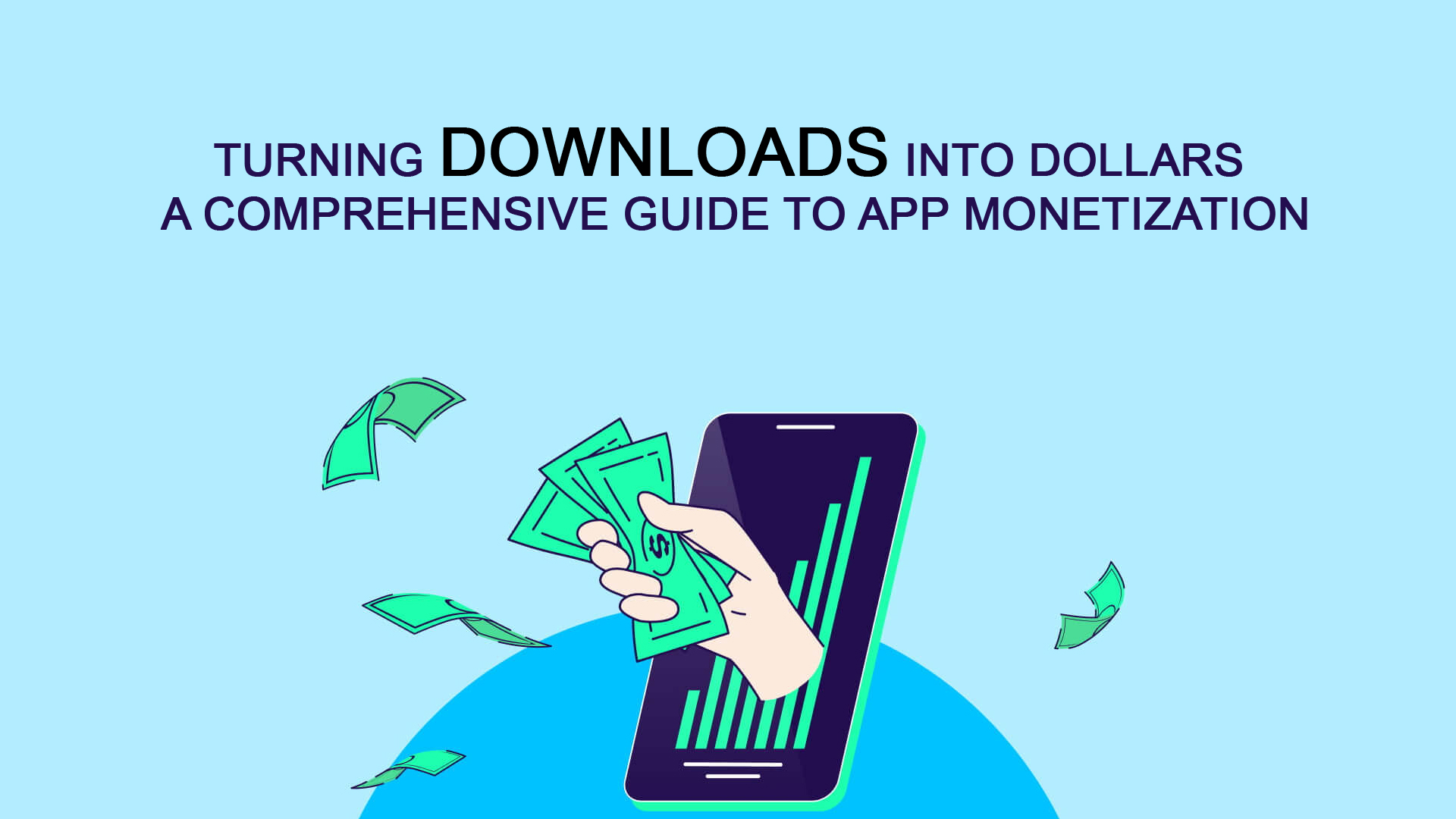Turning Downloads into Dollars: A Comprehensive Guide to App Monetization
In the bustling digital marketplace of 2025, launching an app is just the first step. The true challenge and ultimate goal for many developers and businesses lie in app monetization – transforming user engagement and downloads into sustainable revenue streams. While a free app can quickly gain traction, understanding and implementing effective monetization strategies is crucial for long-term viability, growth, and profitability.
This comprehensive guide will deep-dive into the diverse world of app monetization, exploring various models, best practices, and emerging trends that are shaping how apps generate income in 2025. Whether you’re a indie developer, a startup, or an established enterprise, mastering monetization is key to turning your app vision into a thriving business.
The App Monetization Landscape: A Strategic Imperative
Why is app monetization so critical?
- Sustainability: Even the most passion-driven projects need financial resources for ongoing development, maintenance, server costs, and marketing.
- Growth: Revenue allows for reinvestment in new features, expanding your team, and reaching a wider audience through marketing campaigns.
- Profitability: Ultimately, for many, an app is a business. Monetization strategies are designed to generate profit and a return on investment.
- Innovation: Financial stability enables you to explore new technologies, integrate cutting-edge AI, and push the boundaries of what your app can do.
Choosing the right monetization model isn’t a one-size-fits-all decision. It depends heavily on your app’s genre, target audience, core value proposition, and overall business goals.
Primary App Monetization Models
Let’s explore the most prevalent and effective app monetization strategies:
- In-App Advertising (IAA): The Ubiquitous Revenue Stream This is one of the most common models, where apps display various forms of advertisements to their users. It’s particularly popular for free-to-download apps, relying on high user engagement and traffic.
- Types of In-App Ads:
- Banner Ads: Small, rectangular ads typically displayed at the top or bottom of the screen. They are least intrusive but also have the lowest click-through rates.
- Interstitial Ads: Full-screen ads that appear at natural transition points within the app (e.g., between levels in a game, after completing a task). Highly engaging but can be disruptive if not placed thoughtfully.
- Rewarded Video Ads: Users watch a short video ad in exchange for an in-app reward (e.g., extra lives, virtual currency, premium content access). This model is highly effective as it offers value to the user and is opt-in, leading to higher completion rates.
- Native Ads: Ads that blend seamlessly with the app’s content and design, making them less intrusive and more engaging. They match the look and feel of the app, improving user experience.
- Playable Ads: Interactive mini-games that users can play for a short period before being prompted to download the advertised app. Highly engaging and effective for game promotion.
- Pros:
- Easy to implement with SDKs from ad networks.
- Low barrier to entry for users (app is free).
- Scalable with user base growth.
- Diverse ad formats available.
- Cons:
- Can degrade user experience if not implemented carefully.
- Requires a large, active user base for significant revenue.
- Lower revenue per user compared to other models.
- Risk of “ad fatigue” where users become desensitized.
- Reliance on ad network payouts.
- Privacy concerns (e.g., IDFA changes on iOS and Android privacy sandbox initiatives impacting ad targeting).
- Types of In-App Ads:
- In-App Purchases (IAPs): Unlocking Value Within the App IAPs allow users to buy digital goods, content, or features directly within the app. This model is incredibly versatile and powers much of the revenue in gaming, but it’s equally effective for productivity and content apps.
- Types of In-App Purchases:
- Consumables: Items that can be used up (e.g., virtual currency, extra lives, boosts in a game). Users can buy them repeatedly.
- Non-Consumables: Permanent items or features (e.g., removing ads, unlocking premium levels, special characters, pro features in a productivity app). Bought once and owned forever.
- Subscriptions: Recurring payments for access to premium content, features, or services for a specific period (e.g., monthly, annually). This is a highly stable and predictable revenue stream.
- Freemium Model: A combination where the basic app is free, but premium features or an ad-free experience require a one-time purchase or subscription.
- Pros:
- High revenue potential, especially for popular items or subscriptions.
- Enhances user experience by offering exclusive content or features.
- Provides flexibility for users to pay for what they value most.
- Subscriptions offer predictable recurring revenue.
- Cons:
- Requires strong in-app content or valuable features to entice purchases.
- Conversion rates can be low if value isn’t clear.
- Requires careful balancing to avoid a “pay-to-win” perception in games.
- Platform fees (Apple and Google typically take 15-30% of IAP revenue).
- Types of In-App Purchases:
- Paid Apps (Premium Apps): The Upfront Cost In this traditional model, users pay a one-time fee to download and access the app.
- Pros:
- Simple and transparent monetization.
- No ongoing monetization effort required post-purchase.
- Users who pay upfront are often more engaged.
- Often associated with higher quality or specialized niche apps.
- Cons:
- Significant barrier to entry for users, leading to fewer downloads.
- Requires strong marketing and a compelling value proposition to convince users to pay upfront.
- Lower discoverability in crowded app stores compared to free apps.
- Limited opportunities for recurring revenue unless combined with IAPs.
- Pros:
- Subscription Model: The Future of Recurring Revenue While a type of IAP, the subscription model warrants its own focus due to its growing dominance, particularly in non-gaming apps. Users pay a recurring fee for continuous access to premium content, features, or services.
- Pros:
- Predictable and Stable Revenue: Provides a consistent cash flow, making financial planning easier.
- Higher Lifetime Value (LTV): Engaged subscribers generate significantly more revenue over time.
- Incentive for Continuous Improvement: Encourages developers to regularly update content and features to retain subscribers.
- Exclusivity: Creates a sense of premium value for subscribers.
- Cons:
- Requires a strong and consistently updated value proposition to justify recurring payments.
- High churn risk if users don’t perceive ongoing value.
- Customer acquisition costs can be higher as you need to convince users to commit to recurring payments.
- Requires robust user onboarding and retention strategies.
- Pros:
- Affiliate Marketing & E-commerce: Apps can integrate with e-commerce platforms or promote products/services from other businesses, earning a commission on sales or leads generated through the app.
- Pros:
- Can be less intrusive than traditional ads if relevant.
- Diversifies revenue streams.
- Leverages existing user trust in the app.
- Cons:
- Requires careful selection of relevant affiliate partners.
- Success depends on conversion rates of promoted products.
- Can dilute the app’s core purpose if not implemented carefully.
- Pros:
- Data Monetization (with caution): Aggregated and anonymized user data (e.g., usage patterns, preferences) can be sold to third-party companies for market research or analytics.
- Pros:
- Passive income stream.
- Cons:
- Major Privacy Concerns: Highly sensitive area, requires explicit user consent, strict adherence to data protection regulations (GDPR, CCPA, India’s PDP Bill), and transparency. Missteps can lead to severe reputational damage and legal penalties.
- Lower revenue compared to other models.
- Requires significant technical expertise to manage data securely.
- Pros:
Hybrid Monetization Strategies: The Best of Both Worlds
Many successful apps employ a hybrid approach, combining multiple monetization models to maximize revenue while optimizing user experience.
- Freemium with Ads and IAPs: The most common hybrid, where the app is free, uses ads for basic users, and offers IAPs (like “remove ads” or premium features) for those willing to pay.
- Paid App with Subscriptions: An upfront payment for core functionality, with subscriptions for advanced features or ongoing content updates.
- Rewarded Ads and IAPs: Games often combine opt-in rewarded video ads with various IAPs for virtual goods and progression.
The key to a successful hybrid model is seamless integration and clear communication of value to the user.
Key Considerations and Best Practices for App Monetization
- Value Proposition is King: Users will only pay or tolerate ads if your app provides significant, consistent value. Focus on solving a real problem or offering unique entertainment.
- User Experience First: Never compromise the user experience for the sake of monetization. Intrusive ads or forced purchases will lead to uninstalls.
- Understand Your Audience: Different demographics and app genres respond to different monetization models. Research your target users’ willingness to pay and their preferences.
- Optimize Pricing: A/B test different price points for IAPs and subscriptions to find the sweet spot that maximizes conversion and revenue.
- Clear Call to Actions (CTAs): Make it easy for users to understand what they are purchasing and the benefits they will receive.
- Offer Value for Ads: If using ads, consider offering users an option to remove them via an IAP, or provide incentives for watching rewarded videos.
- Retention is Paramount: It’s more cost-effective to retain existing users than to acquire new ones. Engaged users are more likely to convert into paying customers.
- Leverage Analytics: Use in-app analytics tools (e.g., Google Analytics for Firebase, Adjust, AppsFlyer) to track user behavior, conversion rates, ARPU (Average Revenue Per User), LTV (Lifetime Value), and identify monetization opportunities or bottlenecks.
- A/B Testing: Continuously test different monetization strategies, ad placements, IAP offers, and pricing tiers to optimize performance.
- Transparency and Trust: Be transparent with users about data collection and how their data is used, especially if considering data monetization. Adhere strictly to privacy regulations.
- Seasonality and Events: Plan promotions and special offers around holidays, seasonal events, or major updates to boost IAP sales or subscriptions.
- Gamification for Engagement: For non-gaming apps, incorporate gamified elements to boost engagement, which can lead to higher ad views or IAP conversions.
- Localization of Offers: Tailor IAP prices and ad content to different geographical markets, considering local purchasing power and cultural nuances.
Emerging Trends in App Monetization (2025 and Beyond)
The app monetization landscape is dynamic, with new trends constantly emerging:
- Subscription Fatigue & Tiered Subscriptions: As users subscribe to more services, “subscription fatigue” is a real concern. Apps will increasingly offer more granular, tiered subscription options to cater to different budget levels and feature needs.
- Web3 and Decentralized Monetization: The rise of blockchain technology and Web3 promises new monetization models, including:
- NFTs (Non-Fungible Tokens): Users owning unique digital assets within apps (e.g., game items, digital art) that can be bought, sold, or traded, creating secondary markets.
- Token-Gated Content/Features: Access to premium content or features might be granted by holding specific cryptocurrencies or NFTs.
- Play-to-Earn (P2E) / Move-to-Earn (M2E) Models: Particularly in gaming and fitness, where users earn cryptocurrency or NFTs by playing or being active.
- AI-Powered Personalization of Offers: AI will increasingly analyze user behavior to offer highly personalized in-app purchases, ad experiences, or subscription trials at the optimal moment, maximizing conversion rates.
- Beyond Advertising: Direct Brand Sponsorships: Apps with large, engaged niche audiences might directly partner with brands for integrated content or exclusive experiences that feel less like traditional ads and more like valuable collaborations.
- Micro-Subscriptions for Niche Features: Instead of a single high-tier subscription, apps might offer very low-cost, recurring subscriptions for specific, highly desirable micro-features.
- “Creator Economy” Integration: Apps serving creators (e.g., content creation, social platforms) will enable direct monetization for creators through tips, badges, or direct fan subscriptions, taking a cut of the transaction.
- Data Ethics and Compliance Driving Innovation: With increasing regulatory scrutiny (like India’s Personal Data Protection Bill, 2023), transparency in data monetization will become even more critical, pushing for privacy-preserving technologies and user-centric data control.
- Contextual and Behavioral Advertising (Post-Cookie/IDFA World): As third-party cookies and device identifiers become less prevalent, ad tech will rely more on contextual targeting and on-device behavioral analysis, requiring careful app integration.
Conclusion
App monetization is a continuous journey of experimentation, optimization, and adaptation. There’s no single magic bullet; rather, it’s about strategically choosing and iteratively refining the models that best align with your app’s value, your audience’s preferences, and your business objectives.
By prioritizing user experience, leveraging data analytics, embracing hybrid approaches, and staying ahead of emerging trends, developers and businesses can unlock the full revenue potential of their mobile applications, ensuring not just downloads, but sustained growth and profitability in the dynamic app economy of 2025 and beyond. The future of app monetization is about creating value, building trust, and fostering a mutually beneficial relationship between the app and its users.




